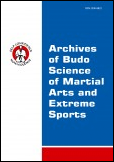2016, Volume 12, Issue 1
The individual offensive effectiveness of top level soccer players during an encounter and in close contact with an antagonist – secondary analysis based on the methodological criterion of the theory of combat sports
Jerzy Brzyski1
1Department of Sport, Gdansk University of Physical Education and Sport, Gdansk, Poland
Author for correspondence: Jerzy Brzyski; Department of Sport, Gdansk University of Physical Education and Sport, Gdansk, Poland; email: jerzy.brzyski[at]onet.eu
Full text
Abstract
Background and Study Aim: In all team games with different frequency, it comes to an encounter of players (“one against one” or “one against group”) from opposed teams. Regardless of similarities, the specialists of particular team games base the analysis of such events on specific methodologies and consequently on different terminology (different languages). The aim of this study is the individual offensive effectiveness of top level soccer players during such encounter and in close contact with an antagonist based on the methodological criterion of analysis of the theory of combat sports.
Material and Methods: The analysis of the matches between the national teams of Poland and Germany fought over in qualifying groups during the 2006 World Cup finals (0 : 1) and the 2008 European Championship (0 : 2). Effectiveness and reliability indicators were applied to assess individual actions of a soccer player from the perspective of team effectiveness. Secondary analysis of these indicators based on criterion of struggle dynamics measurement (according to the theory of combat sports) was applied in order to develop personal profiles broken down into formations (defenders, midfielders, strikers).
Results: In both matches, the members of German national team outnumbered Polish players in terms of all offensive effectiveness indicators in close contact (“one against one”, “one against group”) and during an “encounter” (“one against one”). As far as the 2006 World Cup is concerned, statistically significant differences were as follows: personal offensive dynamics (POD Index) p<0.05; individual offensive effectiveness (IOE) p<0.01; offensive effectiveness “one against group” (OAG) p<0.01; whereas in the case of the 2008 European Championship they amounted to: POD Index p<0.01; OAG p<0.01; encounter effectiveness (EE) p<0.01; offensive effectiveness “one against one” (OAO) p<0.01.
Conclusions: Profiles of individual soccer players are the empirical basis for the development of individual training programs. With the profiles of soccer players from the opposed team it is possible to develop tactics for limiting the effectiveness of leaders during an encounter, “one against one” and in close contact with an antagonist and a group of players.
Key words: combat dynamics phenomenon, encounter, extreme situation, fun forms of martial arts, motor safety, reliability





